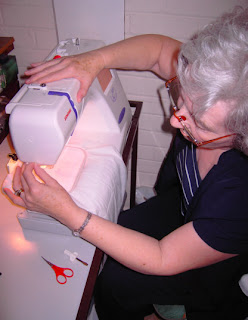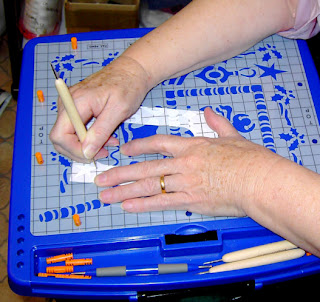 Our international trend continues this week with a project from Jean Isley in England. Growing up during WW2, Jean did a lot of knitting and hand embroidery at a very young age. Her love of crafting carried over into her adult life and early this year she received an embroidery machine as a Golden Wedding anniversary gift. Already it is considered to be one of her most treasured presents and she is sharing her gift with others in both traditional and unique ways. Recently she took inspiration from some very old silk cards and has made some very special greeting cards for the most treasured people in her life. I'm honored that she is now sharing her story with our community.
Our international trend continues this week with a project from Jean Isley in England. Growing up during WW2, Jean did a lot of knitting and hand embroidery at a very young age. Her love of crafting carried over into her adult life and early this year she received an embroidery machine as a Golden Wedding anniversary gift. Already it is considered to be one of her most treasured presents and she is sharing her gift with others in both traditional and unique ways. Recently she took inspiration from some very old silk cards and has made some very special greeting cards for the most treasured people in her life. I'm honored that she is now sharing her story with our community.
Jean's Description
I am an English 'Crafter' very, very appreciative of your free embroidery designs. Using your free designs, I am busy making Christmas Greeting Cards to give to Members of our Carpet Bowls club. To date, I have made in excess of 30 cards - some in the form of postcards, some traditional cards.
Bowls club. To date, I have made in excess of 30 cards - some in the form of postcards, some traditional cards.
Step by Step:
Download and convert design zip files to JEF format & Janome hoop sizes (or whatever format you need for your machine). Transfer to embroidery card ready for stitching design. To be 'frugal' with top and backing materials I like to use the B hoop and position designs to enable 4 designs to be stitched. I prefer to use muslin with stitch and tear stabilizer. When making 'envelope' cards in the style of WW1 sweetheart cards I use nylon to simulate silk with see through backing.

POSTCARDS: Templates of postcard back on computer - some plain reverse, some with designs on reverse. Stitched design is stuck on to this ready to accommodate the cut-out front. Various embellishments can be added to card for desired effect or before sticking to back, if preferred, front can be embossed.
TRADITIONAL CARDS:
Made as above with an extra piece of card fixed to left-hand edge and folded back to form an opening card.
What Makes This Project Special
Making greetings cards has become a passion. I make cards 'in the style of' WW1 silk cards send home by the troops to loved ones back home. Very time consuming but everyone who sees them falls in love with them, so I consider it to be time well spent.
Skill Level:
When the software has been mastered the possibilities are endless. I'm sure most computer literate people would be able to master the techniques.
ProductsI use a Janome 300E Embroidery machine with Digitizer Pro
software. Also necessary for the project is a computer and printer,
embroidery designs,
thread, compact flash discs, embosser and all the usual glues, peel-offs,
embellishments etc. for card making.
 Time Investment:
Time Investment:Quite time consuming. Obviously an
elaborate stitched design takes much longer than a
simple one. Assembly of the card can take up to 1 hour, thinking time takes longer in some cases more than others!!
Why I Love This Project
My husband bought my machine for a Golden Wedding Anniversary gift in April, 2007. Before that time I had done nothing like this at all. As a very small child, during WW2, I always had craft projects, mostly making knitted socks, gloves, and dolls dressed in uniforms to sell for the war effort. I even remember embroidering tablecloths on flour sacks (I have no idea where or how my mother was able to acquire the materials when everything was dependent on coupons). When a friend come across some WW1 silk cards that had belonged to her Grandmother, I thought they were beautiful and wondered how I could make cards remotely like them. The embroidery machine enables me to do this, but they take even more time to make & are left for very special occasions.
Send Us Your CreationsDo you have any creations that go with a great story? If so, we'd love to hear about them, and see them! If we choose to post your project, you'll get a free $25 gift certificate to use in the AnnTheGran.com online store. Click
here for details on how to submit your creation.
What Would You Do?Jean received her embroidery machine as a present for a very special anniversary. Click on the Comments link to share with us when and why you received your first embroidery machine.